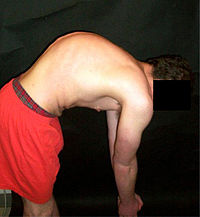
Photo from wikipedia
STUDY DESIGN Retrospective analysis of prospectively collected dataObjective. To report the follow-up curve behaviors in different Sanders staging groups. SUMMARY OF BACKGROUND DATA Vertebral Body Tethering (VBT) is a growth… Click to show full abstract
STUDY DESIGN Retrospective analysis of prospectively collected dataObjective. To report the follow-up curve behaviors in different Sanders staging groups. SUMMARY OF BACKGROUND DATA Vertebral Body Tethering (VBT) is a growth modulation technique that allows gradual spontaneous follow-up curve correction as the patient grows. There is a lack of scientific evidence regarding appropriate patient selection and timing of implantation. METHODS Patients were grouped into five as: Sanders 1, 2, 3, 4-5 and 6-7. Data were collected preoperatively, at the day before discharge, and at each follow-up. Outcome measures were pulmonary and mechanical complications, readmission and reoperation rates. Demographic, perioperative, clinical, radiographic and complication data were compared using Fisher-Freeman-Halton exact tests for categorical variables and Kruskal Wallis tests for the continuous variables. RESULTS Thirty-one (29F, 2 M) consecutive patients with a minimum of 12 months of follow-up were included. The mean age at surgery was 12.1 (10-14). The mean follow-up was 27.1 (12-62) months. The mean preoperative main thoracic curve magnitude was 47°±7.6°. For all curves, preoperative and first erect curve magnitudes, bending flexibility and operative correction percentages were similar between groups (for all comparisons, p > 0.05). The median height gained during follow-up was different between groups (p < 0.001), which was reflected into median curve correction during follow-up. Total curve correction percentage was different between groups (p=0.009). Four (12.9%) patients had pulmonary and 6 (19.4%) had mechanical complications. One (3.2%) patient required readmission and 2 (6.5%) required reoperation. Occurrence of pulmonary complications was similar in Sanders groups (p = 0.804), while mechanical complications and overcorrection was significantly higher in Sanders 2 patients (p = 0.002 and p = 0.018). CONCLUSIONS Follow-up curve behavior after VBT is different in patients having different Sanders stages. Sanders 2 patients experienced more overcorrection, thus timing and/or correction should be adjusted, since Sanders 3, 4 and 5 patients displayed a lesser risk of mechanical complications. LEVEL OF EVIDENCE 3.
Journal Title: Spine
Year Published: 2020
Link to full text (if available)
Share on Social Media: Sign Up to like & get
recommendations!